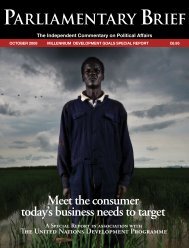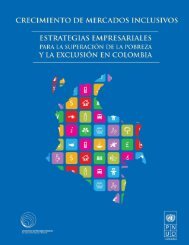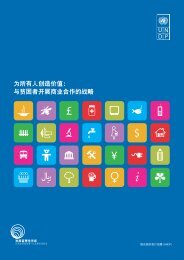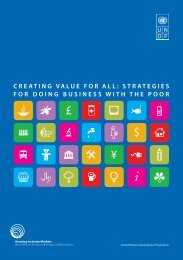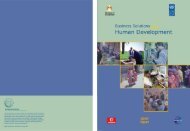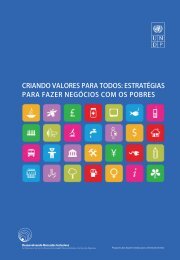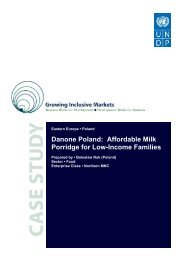Truong Thanh Furniture Corporation - Growing Inclusive Markets
Truong Thanh Furniture Corporation - Growing Inclusive Markets
Truong Thanh Furniture Corporation - Growing Inclusive Markets
You also want an ePaper? Increase the reach of your titles
YUMPU automatically turns print PDFs into web optimized ePapers that Google loves.
South-East Asia • Vietnam<strong>Truong</strong> <strong>Thanh</strong> <strong>Furniture</strong> <strong>Corporation</strong>:Keep the Earth Always GreenPrepared by • Minh Kieu NguyenReviewed by • Usha JumaniSector • Agriculture and Forestry, Consumer goodsEnterprise Class • Large domestic company
Executive SummaryThe case study of <strong>Truong</strong> <strong>Thanh</strong> <strong>Furniture</strong> <strong>Corporation</strong> (TTFC) portrays a business’contribution to poverty reduction in Vietnam. The evolution of TTFC from a private woodprocessing workshop to a large corporation is linked to a person who is viewed as the coreactor in the company – Mr. Vo <strong>Truong</strong> <strong>Thanh</strong>.Mr. <strong>Thanh</strong> realized in 1993, after 10 years as officer in a state-owned organization in Dak LakProvince, that poor people have little opportunity to move out of poverty unless jobs arecreated that produce added income and value. Dak Lak Province was one of the poorestprovinces in terms of income and education. Without opportunities, the poor would continuecutting trees and burning forest to get land for cultivation and wood for heating which couldnot improve their income or living conditions remarkably because the value created fromfarming cultivation is too low. Mr. <strong>Thanh</strong> decided to stop working for the state-ownedorganization and set up his own private business: <strong>Truong</strong> <strong>Thanh</strong> Wood Processing Workshop.A short time after operating, <strong>Truong</strong> <strong>Thanh</strong> Enterprise brought positive results in creatingjobs and income for poor people and, of course, profits for the business as well. In 2000,however, Mr. <strong>Thanh</strong> realized the new challenges if operating as a private wood processingworkshop. Firstly, the source of wood supply was gradually exhausted and exploring woodfrom the natural forests was prohibited because of its terrible damage to the environment.Secondly, the markets for exporting <strong>Truong</strong> <strong>Thanh</strong> products have expanded and arerequesting high quality criteria that <strong>Truong</strong> <strong>Thanh</strong> would not meet if it does not invest andchange the technology. These requirements were beyond the capacity of a wood processingworkshop. To overcome these challenges, <strong>Truong</strong> <strong>Thanh</strong> set up plantations to grow forest.<strong>Truong</strong> <strong>Thanh</strong> had changed its business model to become a company to raise capital for newinvestment. After more than 15 years operating, it has quickly developed to become a publiccorporation and was listed on Ho Chi Minh Stock Exchange in 2008.Today, <strong>Truong</strong> <strong>Thanh</strong> <strong>Furniture</strong> <strong>Corporation</strong> (TTFC) is known as a large domestic companywhich works on growing forests and processing and exporting wooden products in Vietnam.Its products consist of indoor, outdoor, floorings and others, which are mainly exported tomarkets such as the United States, European Union, Japan, Australia and locally purchasedvia its distribution agencies across the country.<strong>Truong</strong> <strong>Thanh</strong> has become a large wood processing group in Vietnam with seven subsidiarycompanies, more than 1,400 employees and a total equity of VND660 billion (US$34million). The company has experienced high growth during the last 15 years. Its growth andsuccess has considerably contributed to create 6,500 jobs and income for farmers andprocessing workers.1
Introduction<strong>Truong</strong> <strong>Thanh</strong> <strong>Furniture</strong> <strong>Corporation</strong> (TTFC) is a Vietnamese business located in Tan UyenDistrict, Binh Duong Province – a province that experienced fast economic growth rate inrecent years thanks to the local government policy of attracting foreign investment anddeveloping industrial zones. TTFC is one of the largest wooden furniture manufacturers inVietnam with chartered capital of VND200 billion (US$10 million).TTFC has seven modern-technology factories and over 6,500 employees including woodprocessing workers and forest farmers. Its main products include indoor furniture, outdoorfurniture, floorings and others such as sawn timber, wooden components, etc. 85% of TTFC’sproducts are exported to foreign markets such as the US, EU, Japan, Australia, and NewZealand. Only 15% of products are sold in domestic markets through its distribution channels.From its start as a wood processing workshop with about 30 workers in Dak Lak Province in1993 TTFC acquired the VINAPRIMART factory in 2000 after seven years in operation.TTFC has rapidly developed and expanded its operations to near provinces such as BinhDuong, Ho Chi Minh City and Phu Yen. As a result, TTFC currently has seven modernizedfactories located in these provinces, the largest one of which is located in Tan Uyen District,Binh Duong Province.Currently, TTFC has developed into the holding company of <strong>Truong</strong> <strong>Thanh</strong> Group includingseven subsidies with modern infrastructure, machinery and equipments in accordance withEuropean standards and has become one of the leading wood processing corporations andexporters in Vietnam.The company has experienced high growth rates over the last 15 years. Its growth and successhas created jobs and income for forest farmers and wood processing workers. A large numberof poor farmers work part-time for TTFC’s plantations for additional income. Others who areyoung and have working skills switched from farming to wood processing. This has resultedin significant contribution to poverty reduction in Vietnam.<strong>Markets</strong> and Position of TTFC in the woodprocessing and exporting industryThe main markets of Vietnam’s wood processing industry are abroad. According to statisticsby the Ministry of Trade, the export turnover of this industry was about more than US$200million in 2002. However, the turnover reached almost US$2 billion in 2006, a ten-foldincrease after four years. Since 2002, Vietnam’s wooden product exports’ turnover hasdramatically increased at an average annual growth rate of 30%. This rate is estimated tocontinue in the future as the world’s demand for wooden products remains high. Table andfigure 1 show the markets of the wood processing and exporting industry of Vietnam in 20052
and 2006, with the US, EU and Japan being the largest markets. Besides, China, Australia andNew Zealand are potential markets.Figure 1: <strong>Markets</strong> of Vietnam wood processing industry in 2006Source: General Department of Customs of Vietnam, Statistical Yearbook, 2006With close to US$2 billion in turnover in 2006 (see table 1), Vietnam’s wood processingindustry was ranked in the fourth position in Asean countries, after Malaysia, Indonesia andThailand. The demand for wooden products is estimated to be very high in the future whereasthe Vietnam’s market share is only about 0.78% of the world total markets. This is potentialfor Vietnamese wood processing companies like TTFC.Table 1: The markets and turnover of Vietnam wood processing and exportingindustry2006 2005<strong>Markets</strong> Amount VND Amount USD Percentage Amount VND Amount USD PercentageUS 744,083,385 $47,879,657 40.39% 566,968,429 $36,855,859.50 37.85%EU 491,190,599 $31,606,723 26.66% 445,256,962 $28,943,989.11 29.72%Japan 286,799,143 $18,454,712 15.57% 240,873,378 $15,658,006.55 16.08%China 94,067,697 $6,052,990 5.11% 60,341,237 $3,922,490.28 4.03%Other Asia 156,205,419 $10,051,376 8.48% 128,581,883 $8,358,482.72 8.58%Australia andNew Zealand69,987,229 $4,503,480 3.80% 55,912,957 $3,634,629.34 3.73%Total 1,842,333,472 $118,548,937 100.00% 1,497,934,846 $97,373,457.49 100.00%Source: General Department of Customs of Vietnam, Statistical Yearbook, 2006According to Vietnam Timber and Forest Product Association, Vietnam has about 2,000wood processing enterprises, of which 640 (including 240 foreign invested companies and400 Vietnamese enterprises) export their products to international markets. However, onlyabout 30 Vietnamese firms have capability of international marketing and direct selling toretail chains in the world without the intermediary role of foreign trading companies, and3
TTFC is one of these 30 companies. TTFC has been a direct supplier to leading supermarketssuch as Carrefour, Metro, Tesco, Cosco and Homebase. In addition, it is a supplier of wellknownretail shops such as Alexander Rose, Alinea, Lapeyre and Hartman.From a small wood processing workshop in 1993, TTFC has impressively developed over 15years and become one of the leading wood processors and exporters in Vietnam. In 2006,TTFC was ranked in the 12 th position among wood processing and exporting companies inVietnam. In ranking among wood processing and exporting companies owned by Vietnamese,TTFC was in the second position after Cam Ha <strong>Corporation</strong> (see table 2 below).Table 2: TTFC’s position in Vietnam wood processing industry, ranked by USDturnoverCompany Ownership Turnover (USD)1. Scancom Co.Ltd. Foreign 41,637,8872. Green River Wood & Lumber Co. Ltd. Foreign 40,801,2463. Theodore Alexander Co. Ltd. Foreign 34,591,5884. Poh Huat Co. Ltd. Foreign 34,561,1595. San Lim <strong>Furniture</strong> Co. Ltd. Foreign 34,126,2616. Latitude Tree Co. Ltd. Foreign 29,844,0147. Kaiser Wood Industry Co. Ltd. Foreign 28,807,2678. Great Veca Co. Ltd. Foreign 26,148,9779. Koda International Co. Ltd. Foreign 25,826,03310. Cam Ha <strong>Corporation</strong> Vietnam 25,223,37411. Standart Furiniture Co. Ltd. Foreign 21,023,01612. <strong>Truong</strong> <strong>Thanh</strong> <strong>Furniture</strong> <strong>Corporation</strong> Vietnam 20,137,93013. RK Resources Co. Ltd. Foreign 19,656,99114. Vietnam-Japan Paper Material Co. Ltd. Foreign 19,131,50015. Johson Wood Co. Ltd. Foreign 18,620,162Source: The Trade Ministry of Vietnam, 2007In 2007, after two subsidiary companies had started their operations, TTFC’s turnover hasincreased remarkably and this led TTFC to the first position among Vietnamese woodmanufacturers and the top five in Vietnam after four foreign invested companies. The typicaldifference of TTFC compared with other wood processing companies is that TTFC links itswood processing activities with forest activities for sustainable growth objectives. With twoplantations growing by 15,000 hectares per year, TTFC is ranked at the leading position in thefield of forest.Though having a high position on the export markets, TTFC’s position on the domesticmarket is not high. TTFC has just started penetrating the local market since 2005. Accordingto the company’s research on domestic consumers, the <strong>Truong</strong> <strong>Thanh</strong> brand name is nowstanding at the sixth position after Taiwan Interior Supermarket, Hoang Anh, Nha Xinh, Nha4
Dep and Pho Xinh. Currently, TTFC has 9 distributors and 4 retail shops 1 . The companyplans to expand and increase its local retail shops to 20 for achieving the objective of raisingthe domestic market proportion to 30% in 2010.Diversified strategy into domestic market can help TTFC to explore the local market andsupply high quality furniture products to Vietnamese consumers. The domestic market is nowconsidered a great potential because Vietnam has a population of 85 million people and theincome per capita has remarkably increased in the recent years along with the growth of theeconomy and life condition improvements.TTFC’s Evolution and its OperationsTTFC’S EVOLUTIONOriginated from a private wood processing workshop, TTFC has impressively developed tobecome a large corporation with many subsidy companies established over time. After sevenyears operating as a private workshop, Mr. <strong>Thanh</strong> realized that wood processing industry hada great potential for development. However, it was hard for his business to expand anddevelop if operating as a private workshop due to lack of capital for investing in technology,developing raw material zones and penetrating international markets. At that time, hisbusiness faced many difficulties such as lack of capital, skill labour, and sustainable sourcesof raw material. With this thinking, Mr. <strong>Thanh</strong> decided to change his business into a limitedcompany.The evolution of TTFC has been characterized through important points of time since 1993 todate, as follows:• 1993: <strong>Truong</strong> <strong>Thanh</strong> was established as a wood processing private enterprise in DakLak Province.• 2000: <strong>Truong</strong> <strong>Thanh</strong> <strong>Furniture</strong> Co., Ltd (TTFC) was established as a limited companyin Binh Chuan, Thuan An, Binh Duong Province and acquired VINAPRIMART, a100% foreign invested company.• 2001: For the first time, TTFC participated in international fairs in Singapore, the US,and Japan and approached more than 300 potential importers for starting the directselling program to leading supermarkets such as Carrefour, Homebase, Castorama,Tesco.• 2002: Foreign customers ordered over the capacity, TTFC was established in ThuDuc, Ho Chi Minh City for its expansion.1 In Danang, Nha Trang, Buon Ma Thuot, Dalat, Ho Chi Minh City, Binh Duong, Binh Phuoc, Vung Tau,and Long Xuyen.5
• 2003: <strong>Truong</strong> <strong>Thanh</strong> <strong>Furniture</strong> Co., Ltd was equitized and changed its name into<strong>Truong</strong> <strong>Thanh</strong> <strong>Furniture</strong> <strong>Corporation</strong>. Some key managers were offered the right tobuy TTFC’s shares at the face value to become shareholders.• 2005: <strong>Truong</strong> <strong>Thanh</strong> <strong>Furniture</strong> Co., Ltd in Dak Lak Province was established as asubsidiary company of TTFC.• 2006: Aureos South East Asia Funds (ASEAF) has invested and become the firstforeign shareholder of TTFC. This year, <strong>Truong</strong> <strong>Thanh</strong> Ea H’leo Industrial ParkManagement Joint-stock Company in Dak Lak Province and <strong>Truong</strong> <strong>Thanh</strong> WoodProcessing Joint-stock Company in Binh Duong Province were established assubsidiary companies of TTFC.• 2007: TTFC attracted more foreign shareholders to raise the chartered capital toVND150 billion. This year <strong>Truong</strong> <strong>Thanh</strong> Youth Joint-stock Company in Phu YenProvince and <strong>Truong</strong> <strong>Thanh</strong> Plantation Joint-stock Company in Dak Lak Provincewere established as subsidiary companies of TTFC.• 2008: TTFC is selected as one of 30 businesses to participate in the national brandname program. On 18 February 2008, TTFC has been listed on Ho Chi Minh CityStock Exchange (HOSE) and formally became a public holding corporation, knownas <strong>Truong</strong> <strong>Thanh</strong> Wood Processing Group.TTFC’S PRODUCTS AND FINANCIAL MODELEvolution of TTFC over time has quicklychanged its business model, financial modeland ranges of products. TTFC is committedto sell quality furniture produced with hightechnology and environmental standards.Currently, the company produces four mainranges of products, including indoorfurniture such as tables, chairs, beds, andshelves, outdoor furniture such as tables,chairs, benches, loungers, wine trolley, etc.,Samples of TTFC furniturewooden floorings and wooden timber.Before 2005, TTFC customers from developed countries such as the US and EU often keptfor themselves the exclusive rights to invent and design new products and left massproduction to Asian countries. At that time, TTFC’s products were ordered and producedunder the designs of its foreign customers because TTFC brand name had not been wellknownand TTFC had not clearly known of the foreign customers’ preferences. Realizing thatdesigning and developing bring value added and profits, TTFC invested and spent muchmoney for its research and development of new products. Thanks to such investment since2006, TTFC can manufacture and sell products under its brand-name and design. Currently,as TTFC has clearly understood the demand and preferences of its customers and the TTFC6
and name has gradually become famous. This not only helps the company save productioncosts but also helps its designers be more creative and understood the like of customers.Before 2003, TTFC was a private company financed by the owner’s equity and debts from thebanks. However, in Vietnam, it was not easy for a private limited company to get enoughcapital for expansion because banks themselves lacked sources of capital for lending and theyoften lend maximum 70% of the investment amount whereas the owner’s equity of a privatelimited company is not much. With the expansion programs to meet the increased demand ofits customers, TTFC has recognized the importance and necessity of financing from thefinancial markets. The Board of Directors lead by Mr. Vo <strong>Truong</strong> <strong>Thanh</strong> and Mr. Ta VanNam decided to change TTFC into a corporation in 2003. Five years later, TTFC has gonepublic and has become a public corporation listed on the Ho Chi Minh City Stock Exchange(HOSE). At the moment, TTFC can finance its operations from the capital markets throughissuing bonds and stocks to mobilize capital. Although it continues to use debts from banks,but operating as a public corporation, it is easier for TTFC to raise equity from shareholders’contribution. Thanks to raising equity, TTFC can borrow much more from banks.TTFC MISSIONS AND OBJECTIVESTTFC was set up in 1993 with the clear mission to provide good quality products, competitiveprices, on-time delivery, innovation and good services. To deliver products with competitiveprices as promised, TTFC set up two plantations in Vietnam. This allows TTFC to have bettercontrol over sources of material supply. The small trees are used to make particleboards andthe large logs to produce furniture. TTFC also staggers the trees growth in order to have astable and sustainable supply of raw materials. <strong>Truong</strong> <strong>Thanh</strong> indeed recognizes theimportance of preserving and enhancing the environment as these actions ultimately affect thehealth, safety and welfare of their customers, employees and the surrounding communities.When asked about the objectives of TTFC, Mr. Vo <strong>Truong</strong> <strong>Thanh</strong> does not hesitate to revealits ambitious objectives:• To become one of the 3 highest revenue wood processing and exporting companies inVietnam and ASEAN• To become one of 3 leading brand names on the domestic markets• To become one of 3 largest forest growing companies in ASEAN in 2015• To achieve the growth rate of 20% in revenue and 30% in net income• To achieve an EPS of VND3,000 annuallyVALUE CREATIONTTFC brings the value to forest farmers and wood processing workers through creating jobsand income. In terms of society, its objectives are to create jobs and income for forest farmersand wood processing workers. These objectives are stated in TTF‘s prospectus and oftenremarked in its annual reports. Creating jobs and income for the poor contribute to povertyreduction in rural provinces such as Dak Lak, Phu Yen and Binh Duong. In addition tosupplying raw materials sustainably, growing forests helps TTFC to achieve the objectives of7
environment improvement. The slogan: “Keep the Earth Always Green” shows TTFC’sawareness of environment protection.The company creates and distributes its value among stakeholders including forest farmers,wood processing workers and shareholders. Farmers working at the plantations grow forestsand sell raw wood to the company. The company buys raw materials from forest farmers andimport from other countries to produce wooden products. By 2008, 70% of raw materialswere imported from South Africa, Brazil, Uruguay, Ghana, Togo, Myanmar, New Zealand.The rest was supplied by forest farmers. Farmers are distributed value in the form of incomefrom selling raw wood. However, TTFC plans to reduce the proportion of imported rawmaterials to 20% in 2015 by developing its projects of growing forests. This means that jobsand income of forest farmers will be increased.TTFC uses raw materials imported and bought from farmers to produce wooden products. Itsproducts are then exported to international markets. The processing workers and managementare distributed value in the form of salaries and the shareholders are distributed value in theform of dividends. By processing and exporting products to the international markets, TTFCcreates additional value for wooden products, and then brings additional income for the poorpeople, thus helping them to move above the poverty line.CONSTRAINTS AND OPPORTUNITIESWhen asked about business constraints, Mr. Vo <strong>Truong</strong> <strong>Thanh</strong> does not hesitate to reveal thatthe company has been facing too many issues related to market, regulation, and knowledge offarmers and workers.• <strong>Markets</strong>: TTFC’s key markets include the US, EU, Japan, and Australia. However, in2007 and 2008, there was significant decline in demand from key exporting markets ofTTFC as a result of the global financial crisis, trade problems, high fuel costs, andchanges in exchange rates. To reduce the negative impacts of decline in demand byinternational markets, TTFC has recently penetrated the local markets. With a largepopulation of 85 million people, the domestic market has high potential. However, it isnot easy for TTFC to penetrate the domestic markets. Firstly, the brand names of TTFCare not as strong as other brand names such as Hoang Anh, Nha Xinh, Nha Dep and PhoXinh because TTFC’s products are mainly designed and produced for export markets.Secondly, TTFC’s products are of high quality but are too expensive for low-incomeconsumers.• Regulation: The company has some commitments and its production is dependent uponthe government policies. Changes in policies of growing and exploiting forest, importingwood materials are also the important constraints. For example, the government mayincrease tax rates or apply quota policy on imported wood raw materials. To overcomethese constraints, TTFC has engaged with several provincial governments to reduce theconcentration risk inherent if only working with one single local government. Priorityshould be given to provinces that demonstrate strong commitment and evidence of soundenabling environment.8
• Labour knowledge: Although Vietnam has a young and large labour force, the quality oflabour measured in terms of knowledge and working skills is not very high. This hasaffected TTFC’s production adversely. To overcome these constraints, TTFC usuallyoffers technical courses and training to its processing workers. For example, young andstrong people from farmer households are recruited and trained to directly work inTTFC’s workshops such as logs, timber, grading, air-drying, kiln-drying, rough milling,shaping, assembling, sanding, oiling and coasting. On the other hand, TTFC selectscandidates from its engineers or managers and offer them scholarship for highereducation abroad. These candidates are committed to come back and work as keyengineers and managers for TTFC in the future.Table 3: The total number of TTFC’s employees at the end of 2008Education Managers Indirect employees Direct employees TotalDoctor 1 - - 1Master 17 13 - 30Bachelor 55 205 59 319High school - - 1,063 1,063Total 73 218 1,122 1,413Source: TTFC Annual Report, 2008The TTFC and its RelationshipsThe critical actors that shaped the business include forest farmers, wood processing workersand key managers led by Mr. <strong>Thanh</strong>. At the end of 2008, TTFC had about 1,413 employees,including key managers, indirect and direct employees. The indirect employees are staffs whoare employed to work at the office or management department whereas the direct employeesare workers who are employed to work at processing workshops or plantations. Table 3 aboveshows the number of employees categorized in terms of their education and role. In addition,there are about over 5,000 poor farmers who work as forest farmers or workers at TTFC’splantations. Most forest workers working for plantations are ethnic minorities or unskilledlabour. It is very hard for these people to find a job except for work at TTFC’s plantations asforest workers.TTFC creates jobs and income for forest farmers and wood processing workers. TTFC’ssuccess or failure affects their interests. The shareholders and Board of Directors representedby Mr. <strong>Thanh</strong> have benefited from the success of the company. At present, Mr. <strong>Thanh</strong> leads ateam of 3 key managers known as deputy directors.Mr. <strong>Thanh</strong> is the founder, Chairman and General Director of TTFC. With his excellentknowledge of wood processing industry and 25-years of experience in running and managingthe wood processing business, Mr. <strong>Thanh</strong> plays a very important role in the success of TTFC.He is not only an excellent director but also a good policymaker. During the interview, Mr.9
<strong>Thanh</strong> revealed that he often has policies that encourage other actors’ efforts to work for thesuccess of TTFC.Such policy of encouraging farmers in growing and protecting forests is one of the interestingapproaches presented by Mr. <strong>Thanh</strong>. This policy helps the company to achieve many differentobjectives. Firstly, the company may ensure a sustainable source of material supply at thesame time to create jobs and income for forest farmers. Thanks to this policy, farmers in DakLak Province may have an additional income of VND1.5 to 2 million (US$77 to US$103) permonth. This has contributed remarkably to poverty reduction in rural areas of Vietnam.Secondly, this policy helps the company to gradually replace the imported source of materialwith supply from the natural forest, which is estimated to be replaced by the cheap source ofmaterial supply from the growing forest in the future. With 15,000 hectares of growing foresttoday and up to 100,000 hectares in the future, TTFC itself may meet 30% of its demand forwood raw materials now and 50% in the coming years. Lastly, with this policy TTFC hasmade a significant contribution to recovering forests and improving the environment inVietnam. Additionally, this creates a good image of TTFC as a business with responsibilityand awareness of environmental protection. It also helps the company to achieve the qualitycertificate to export TTFC’s products to the EU markets.In addition, Mr. <strong>Thanh</strong> has encouraged talented employees to work hard and to contributetheir knowledge and management skills for the development of TTFC. This approach hasbeen applied since TTFC changed into a corporation from a private enterprise. In 2003 and in2008, Mr. Vo <strong>Truong</strong> <strong>Thanh</strong> offered the right for key managers to buy TTFC shares at theface value while TTFC’s market value is higher. This policy changed their role from the keymanagers to become shareholders, which contributed for them to help TTFC succeed becausethe success of TTFC benefits themselves in turn. This policy may be considered adifferentiation of TTFC compared with other companies in the wood processing industry inVietnam.Besides Mr. <strong>Thanh</strong>, there are some other key actors who have contributed to the success ofTTFC remarkably. Mr. Ta Van Nam is one of the key managers. He is not only the FirstDeputy General Director but also considered one of the founders of TTFC. Mr. Vo Van Huyand Ms. Ngo Thi Hong Thu are the key managers with high education and good managementskills. To encourage these key managers’ highest efforts, the company has used options as abonus policy for the key managers who have made important contributions. This is aneffective tool to solve the ‘agent problem’ or conflict of interest between key managers andshareholders of TTFC. For this policy, TTFC offers the options to its key managers. The keymanagers have the right to buy TTFC shares at the predetermined price or exercised price.Their benefits are the difference between the market price and exercised price. Therefore,they make effort to run the company so that the market price is always higher than theexercised price. This has also benefited the shareholders because the market value of the firmis maximized.10
Figure 2: Relationships between TTFC and its actorsStakeholders/ActorShareholdersKey managersProcessing workers<strong>Growing</strong>-forestFarmersPlantation workersTTFC<strong>Markets</strong>:• International• DomesticGovernmentsInternationalorganizationsResults Created by TTFCOriginally a private wood processing workshop in 1993, TTFC has quickly become a leadingwood processing and exporting company in Vietnam. After over 15 years operating in thewood processing industry, TTFC has achieved economic, social, and environmental results.The critical actors including key managers, forest farmers and wood processing workers havepositively contributed in achieving results, which have helped to reduce poverty.ECONOMIC RESULTSIn terms of economic results, TTFC has achieved a strong increase in revenues and profits.Thanks to this, the size of the company measured by total assets, total owner’s equity hasincreased remarkably. Table 4 shows the financial results of TTFC over the last three years.In 2008, pre-tax and after-tax profits of TTFC went down as compared with 2007 due to theglobal economic crisis. Nevertheless, its revenue, total assets, and owner’s equity remainedincreasing. Although the 2008 performance was not good because the global crisis stronglyaffected the demand for TTFC’s products from the main markets such as the US, EU and12
Japan, TTFC believes that the results of 2009 will be improved as the state of Vietnam’s andthe global economy will have gradually overcome the crisis.Table 4: Economic results of TTFC during the years 2006 – 2008 (Unit: VNDmillion) 12006 2007 2008Items VDN US$ VDN US$ VDN US$Total assets 489,658 31,421 1,373,330 87,175 1,747,451 106,816Current assets 429,265 27,546 997,994 63,350 1,301,227 79,540Long-term assets 60,393 3,875 375,336 23,825 446,224 27,276Liabilities and owner's equity 489,658 31,421 1,373,330 87,175 1,747,451 106,816Current liabilities 413,573 26,539 687,651 43,650 1,057,722 64,655Long-term debts 15,665 1,005 15,665 994 15,665 958Owner's equity 60,420 3,877 670,014 42,531 674,064 41,203Net sales 325,102 20,862 611,276 38,802 693,200 42,373Operating profits 22,549 1,447 54,353 3,450 20,095 1,228Pre-tax profits 22,861 1,467 58,303 3,701 23,406 1,431After tax profits 22,701 1,457 56,029 3,557 21,295 1,302Source: TTFC Annual Reports, 2006-2008SOCIAL RESULTSDevelopment and economic results of TTFC have significantly affected the social life of therural provinces where TTFC’s factories or plantations are located. TTFC’s establishment andoperation have created a great opportunity for the poor people to move out of poverty byworking as wood processing workers or forest farmers for TTFC. To date, TTFC employsmore than 1,400 employees with the monthly average income of VND2.5 million or US$128.In addition, it creates jobs in growing forest for more than 5,000 poor farmers with additionalincome of VND 60,000 or US$3 per day. Such social results have moved more than 6,000people out of poverty. Household incomes have been increased and, as a result, their livingconditions such as healthcare, childcare, housing and education have improved.ENVIRONMENTAL RESULTSWith high awareness of environmental protection and improvement, TTFC asks itssubsidiaries and stakeholders, especially farmers, to keep the earth always green. Thisphilosophy is selected as the slogan of the company. The awareness of environmentalempowerment and improvement for sustainable development has originated from experienceparticipating in the global wood exporting markets. Understanding that the source of rawwood supply from the natural forest is limited and environmental protection is so important,TTFC has increased its areas of growing forest from thousands of hectare to hundred-13
thousands of hectares. <strong>Growing</strong> forest, exploiting and re-growing are the great ways that helpTTFC to create and combine benefits for all: the business, poor people and the environment.GROWTH STRATEGY AND FUTURE OUTLOOKAt the annual shareholders meeting, TTFC always emphasizes the company’s vision ofachieving a leading position in the expanding forest and wood processing industry in Vietnamand ASEAN countries. In the annual report of 2008, TTFC indicates three long term strategicobjectives of the company. The first strategic objective in the long run is to become adiversified business and manufacturing group, known as a multi-industry group, withoperations including wooden product processing and exporting, growing and harvestingforests, building; leasing; and managing industrial zones, and real estates. However, TTFCremains using 70% of its resources for wood processing and forest growing, the core businessactivities of the company. TTFC plans to plant up to 100,000 hectares of forests in Vietnam.After 4 years of planting, TTFC can have the first harvest and use small trees to produceMDF and particle board. The second and third harvests are planned in year 8 and year 12.Therefore, after 2016, TTFC can supply between 500,000 and 1,000,000 cubic meters ofwood. The second objective is to list TTFC shares on the international stock markets. Thisobjective helps TTFC to mobilize huge sources of capital for expanding its operations andachieving its long term objectives. The last objective is to build up the TTFC brand name tobecome internationally recognized.According to Mr. <strong>Thanh</strong>, to achieve these objectives, TTFC follows a low cost but highquality strategy. TTFC’s low cost strategy is based on implementing local comparativeadvantages which are its strong points in terms of using low cost labour, domestic sources ofraw material supply from forest planted by its plantations, and benefiting from encouraginggovernment policies for businesses having forest growing operations.TTFC’s high quality strategy is based on its strong assets in technology investment, R&D andbuilding up its strong brand name on the international markets. At present, TTFC has many ofthe state-of-the-art machines and equipments in Vietnam. These machines and equipmentswere imported from technologically advanced countries such as Italy, Germany, and Japan.These modern machines and equipments help TTFC to manufacture the products with highquality and lower the ratio of wasted raw materials.To achieve these objectives, TTFC must overcome a number of challenges. The negativeeffect from the global economic crisis is the first challenge. The economic crisis caused thedemand for high quality furniture products to strongly decline and this affects job creationand income improvements for poor farmers and processing workers remarkably.Nevertheless, TTFC expects that the crisis will be over soon. However, when the crisis isover, TTFC may face a new challenge which is often followed after the crisis, that is a lack ofskilled labour forces and experienced managers.14
ReferencesINTERVIEWSMr. Vo <strong>Truong</strong> <strong>Thanh</strong>, Founder and General Director, <strong>Truong</strong> <strong>Thanh</strong> <strong>Furniture</strong> <strong>Corporation</strong>PUBLICATIONSGeneral Department of Customs of Vietnam, Statistical Yearbook, 2006,The Trade Ministry of Vietnam, 2007<strong>Truong</strong> <strong>Thanh</strong> <strong>Furniture</strong> <strong>Corporation</strong> Annual Report, 2007<strong>Truong</strong> <strong>Thanh</strong> <strong>Furniture</strong> <strong>Corporation</strong> Annual Report, 2008WEBSITESwww.truongthanh.com.vn15
AnnexesAnnex 1: Organizational structure of TTFCTRUONG THANH FURNITURE CORPORATIONWood ProcessingOthers<strong>Truong</strong> <strong>Thanh</strong> IncorporatedCompany<strong>Truong</strong> <strong>Thanh</strong> <strong>Furniture</strong>Incorporated Company<strong>Truong</strong> <strong>Thanh</strong> <strong>Furniture</strong> Co., Ltd<strong>Truong</strong> <strong>Thanh</strong> Wood ProcessingJoint-Stock Company<strong>Truong</strong> <strong>Thanh</strong> – Eah’leoIndustrial Park ManagementJoint-stock Company<strong>Truong</strong> <strong>Thanh</strong> Youth Joint-stockCompany<strong>Truong</strong> <strong>Thanh</strong> Plantation JointstockCompany16
Annex 2: Managerial structure of TTFCGeneral Meeting of ShareholdersBoard of SupervisoryBoard of DirectorsSecretary to the Board of DirectorsBoard of Investors RelationGeneral DirectorBoard of Assistants and SecretariesBoard of Internal AuditorsDeputy GeneralDeputy GeneralDeputy GeneralDeputy GeneralDeputy GeneralDirector 1Director 2Director 3Director 4Director 5ProductionPlanning &Sale &AccountingCo-Depart.WoodMarketing& FinanceoperationDepart.Depart.Depart.Depart.QualityDepart.InformaticsDepart.ISODepart.Technical&Admin &HumanDesigningResourceDepart.Depart.ERPPurchasingImport &Project& SupplyExportDepart.Depart.Depart.TrainingDepart.C.o.CDepart.17
The case was completed in December 2010 and released in 2011.The information presented in this case study has been reviewed by the company to ensure its accuracy.The views expressed in the case study are the ones of the author and do not necessarily reflect those ofthe UN, UNDP or their Member States.Copyright @ 2010United Nations Development ProgrammeAll rights reserved. No part of this document may be reproduced, stored in a retrieval system ortransmitted, in any form by any means, electronic, mechanical, photocopying or otherwise, withoutprior permission of UNDP.Design: Suazion, Inc. (NJ, USA)For more information on <strong>Growing</strong> <strong>Inclusive</strong> <strong>Markets</strong>:www.growinginclusivemarkets.org or gim@undp.orgUnited Nations Development ProgrammePrivate Sector Division, Partnerships BureauOne United Nations Plaza, 23 rd floorNew York, NY 10017, USA18






